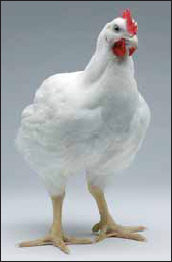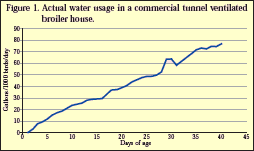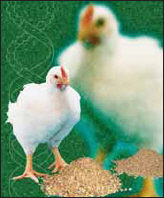



How to control growth to improve economic results
By Brian Fairchild and Mike Lacy, University of Georgia Department of Poultry Science - In many ways a modern broiler is similar to a finely tuned racing car. When all aspects of the maintenance and operation of the racing car are in order, the vehicle performs phenomenally.
The same is true for broilers. With the proper feed, water, and environment, the modern broiler is capable of amazing performance. Finely tuned race cars need meticulous and expert care as do modern broilers. Drivers and their mechanics prepare, maneuver and pace their vehicles. They operate the car to maximize speed over a long race and finish - we emphasize “finish” - the race in the fastest time. Similarly, broiler producers should manage these high performing birds in order to finish the growout to their best advantage.
We want to manage our broilers to maximize health, welfare, productivity and economic return. The genetic potential of the modern broiler is nothing less than extraordinary. Maximizing that genetic potential during growout is a worthy goal, but we might want to consider that a six or seven week growout is similar to a long distance race. It is vital to provide all the nutrients, water, fresh air and other inputs that will allow the bird to grow to its potential, but it is also important to think about pacing the bird to finish the race strong and efficiently.
 Some companies look at fast growth as the ultimate goal and put all their effort into maximizing average daily gain. We contend that striving for growth to maximize profitability, health and livability is a better way to manage broilers. A careful and steady foot on the accelerator and occasionally on the brake provides a better strategy to win the race.Management, lighting and nutrition are key mechanisms for controlling growth rates to optimize broiler health and welfare while achieving economic performance.
Some companies look at fast growth as the ultimate goal and put all their effort into maximizing average daily gain. We contend that striving for growth to maximize profitability, health and livability is a better way to manage broilers. A careful and steady foot on the accelerator and occasionally on the brake provides a better strategy to win the race.Management, lighting and nutrition are key mechanisms for controlling growth rates to optimize broiler health and welfare while achieving economic performance.
For example, feeding broilers an extremely high energy diet to maximize growth throughout the bird’s life is known to make them more susceptible to ascites, sudden death syndrome, chick mortality and leg problems. Most poultry nutritionists think it is wiser to feed a little bit lower energy diet (balanced with all essential nutrients) to keep birds growing at a steady, comfortable and profitable rate. The same can be said for lighting programs. For many years it was commonly recommended that broilers be grown in almost continuous light to stimulate feed intake and maximize growth. Due to the rate at which broilers grow, most producers now provide their birds intermittent light. Lighting programs have been shown to improve health and efficiency of the modern broiler.
In the remainder of this article we will focus on the basic roles of these aspects of broiler production and how they can be utilized to maximize profitability and bird health.
Breeding temperature critical
Newly hatched chicks are not capable of fully regulating their body temperature. Post-hatching factors such as increased body weight, decreased surface area to body mass ratio and growth of down and feathers gradually begin playing a role in thermoregulation. The chick does not become completely homeothermic until sometime between one to two weeks of age. The ability of the broiler to regulate its temperature effectively has a direct impact on growth and efficiency, and thus subjecting chicks to low temperatures results in excess energy being expended to warm the bird by increasing heat production.
Increased mortality, primarily due to an increased incidence of ascites, has also been noted in broilers brooded at low temperatures. Although cold weather and cool brooding temperatures increase feed intake and body weight gain, they are also known to be one of the factors that increase the susceptibility of broilers to ascites. In addition to increased feed intake, low temperatures also cause an increased metabolic requirement for oxygen (Wideman and Tackett, 2000). The increased need by broilers for oxygen at low temperatures, coupled with the requirement to metabolize increased quantities of feed consumed to maintain body temperature, set up an ideal situation for ascites to become a problem (Deaton et al. 1996).
Since chicks are in constant contact with the floor, the temperature of the broiler house floor is actually more important than air temperature. Preheating the broiler house is critical, especially in cold weather. Circulation fans located so as to move hot air off the ceiling and back down to the floor are helpful in warming up the floor more quickly and efficiently during the preheating process. Floor temperatures in houses with forced air furnaces are particularly prone to being too cold if the house is not preheated well before chicks arrive.
Furnaces heat air quickly, but it takes many hours to heat the floor and sidewalls. Cold surfaces in the broiler house will cause heat to be radiated away from the chicks to these cooler surfaces, possibly chilling the birds. A thermometer placed on the litter or an infrared non-contact thermometer can be used to determine if the floor is cold. Floor temperature should be 90°F (32°C) or warmer in furnace heated houses. Of course, floor temperatures in pancake and radiant brooder heated houses will vary anywhere from 75 to 140°F (24- 60°C) depending on whether temperature is measured directly under the brooder or in another location in the house. This is not a problem since the chicks can move to a cooler or warmer area as needed. The importance of proper brooding temperature for broiler chicks has been demonstrated very clearly in research studies (Deaton et al., 1996).
The behavior of chicks should be observed closely for the first week. Much can be learned concerning their comfort by watching and listening. Thermometers are necessary to aid the grower in maintaining correct temperatures; however, temperatures should be adjusted based on chick behavior as well. If the chicks huddle, house temperature must be increased. If they move away from heat sources and appear lethargic or drowsy, they may be too warm.
Don’t underestimate ammonia hazards

Air quality is one of the most difficult aspects of broiler management to grasp. This is probably because it is not possible to “see” air quality. It is difficult to visually determine the volume and direction of fresh air being brought into a broiler house. During cold weather and during the brooding period, the primary function of the ventilation system is to eliminate ammonia and moisture from the broiler house. Many producers underestimate the detrimental effects of ammonia. The human nose is able to detect ammonia levels at around 20 parts per million (ppm). Ammonia concentrations of 50 to 100 ppm cause the eyes to burn and tear.
Obviously, when ammonia levels are high enough to blind birds, production is seriously affected; however, ammonia levels of just 25 ppm have been found to depress growth and increase feed conversion in broilers (Miles et al., 2004). In addition, a greater incidence of airsacculitis, viral infections and condemnations have been linked to ammonia levels in this range.
Ammonia concentrations of just 5 ppm (undetectable by the human nose) have been shown to irritate and injure the protective lining of the chick’s respiratory system, causing increased susceptibility to respiratory disease (Charles and Payne, 1966; Caveny et al., 1981; Al-Mashhadini and Beck, 1985). If one waits until levels are high enough to detect by sense of smell before taking steps to control ammonia, some damage has already occurred.
Ammonia concentrations are increased by moisture, high temperatures, overcrowding and poor ventilation. In most instances, excess ammonia in a broiler house is due to wet litter and insufficient ventilation. The key to minimizing ammonia problems and providing good air quality is controlling moisture in the poultry house.Ventilating to remove moisture and reduce humidity levels in the poultry house is the most effective method of ensuring desirable air quality.
Ventilating by bringing in outside air near the ceiling through planned inlets at a speed conducive to mixing that air with the warm air near the ceiling before the air reaches the floor has proven to be the most efficient and effective way to ventilate during brooding. An air velocity between 500 and 1,000 feet (150 - 300 meters) per minute at the inlet is usually sufficient. Such velocity will allow fresh air entering the house to maintain its momentum along the ceiling of the house and promotes mixing with the warm air that collects there. Lower air velocities result in the cooler air dropping to the floor before being mixed with the warm ceiling air chilling chicks and causing wet litter.
Water - the forgotten nutrient

Water is the most important nutrient consumed by an animal. A bird can survive several weeks without food but only a few days without water. As much as has been written over the years about water in regard to poultry production, it remains the forgotten and underappreciated nutrient. During hatching, chick processing and transportation to the broiler house, it is easy for chicks to begin to dehydrate; therefore, the most immediate need of the day-old broiler is access to clean, fresh water. Waterers must be cleaned, flushed, filled and completely functional before chicks arrive.
During its lifetime, a 5 lb (2.3 kg) broiler will consume about 18 lb (8.2 kg) of water, compared to just 10 lb (4.6 kg) of feed. Studies show that the daily water consumption of a broiler can be approximated by multiplying the age of the bird in days by .2 ounces (5.9 ml) of water (Pesti, et al., 1985). For example, a ten-day old bird will drink about 2 ounces (59 ml) of water during a 24-hour period. Figure 1 depicts actual water usage monitored on a commercial broiler farm.
It is important to know the volume of water a broiler will consume on a given day. Drinking water is often used to provide medications, vaccines, vitamins and electrolytes to broilers. Therefore, to ensure that each bird receives the proper amount, it is essential to estimate consumption. In addition, monitoring daily water consumption of a broiler flock and comparing it to that of past flocks, or to a standard, can alert a producer to potential disease and management problems that may require treatment or corrective actions.
Unfortunately, quite a bit of attention has been focused on the amount of water that drinker systems release in a given period of time. What relevance this measurement has with actual broiler performance is questionable. What is important and relevant is the amount of water consumed and utilized by the bird, not how much runs out of the system when a nipple is artificially activated. Operate systems according to the manufacturer’s recommendations. Water line height is important to balance the amount of water that is consumed by the bird and the water that ends up on the floor.Water lines set too high will reduce the amount consumed by the birds. Water lines set too low will increase the amount on the floor resulting in wet litter, increased ammonia and more condemnations.
Risks in high density diets
The Cobb Broiler Nutrition Guide covers this subject much more expertly and in greater depth than possible in this article. Briefly, the ration fed to broilers varies greatly depending upon availability and cost of ingredients, the size of bird to be grown, time of year, market demands, etc. Most nutritionists feed diets designed to minimize feed costs while maintaining acceptable growth rates and feed conversion.
A preponderance of research studies has shown that feeding high density, high caloric diets to broiler chickens can promote growth related issues such as ascites, sudden death syndrome and leg problems. Feeding less dense, lower caloric diets can reduce these problems. Starter diets that slightly slow early growth with metabolizable energy in the range of 2850 kcal/kg and crude protein levels at 21% are sufficient to promote acceptable growth and minimize problems sometimes associated with extreme growth rates.
Assuming that the lower density diets are not taken to an extreme so as to significantly reduce market weights, an added benefit of slower early growth may be the potential for slightly improved feed efficiency as a result of reduced maintenance requirements. Some research indicates that most weight loss from very early feed restriction can be overcome by broiler chicks (Leeson and Summers, 2005). This phenomenon, known as “compensatory growth,” is not seen when feed restriction occurs during the middle or late stages of the growth period.
Two reliable results of early feed restriction or reduced nutrient levels are better livability and a reduction in metabolic disorders such as ascites, sudden death syndrome, and leg problems. It should be emphasized again that the restriction must not be so severe as to significantly impact final market weight. If growth rate is substantially reduced, the cost associated with the lost weight or with the additional time required to reach market weight may be greater than the savings from the reduced mortality and morbidity.
Understanding lighting programs
Birds are very sensitive to light. In nature, birds take cues from seasonal changes in day length to migrate, begin reproduction or store up energy for later use. Poultry producers have benefitted from this photosensitivity by manipulating light to enhance egg production and growth. Light manipulation is used in broiler production to control growth, improve feed efficiency, minimize mortality and reduce electricity costs.
It has been known for many years that broilers provided essentially continuous light (23 hours light:1 hour dark per day) grow faster than broilers grown using natural daylight and darkness (12 hours light:12 hours dark per day). Light intensities greater than 1 footcandle (10 lux) have been shown to decrease growth rate by stimulating too much activity. For this reason many growers dim lights gradually as birds get older. However, it is important to maintain relatively high levels of light (2.5 footcandles or greater/ 25 lux) for the first few days to encourage bird activity to aid in locating feed and water. It has also been shown that feed efficiency can be improved by dimming lights and by using intermittent lighting schemes such as one hour of light followed by two hours of dark throughout the day. Dimming lights and intermittent lighting probably affect efficiency by decreasing bird activity.
Dark periods as long as 18 hours are not typical in commercial practice; however, shorter periods of darkness (such as 9 -12 hours) have been shown to provide most of the benefits demonstrated with the severe Canadian light restriction.
Finish a winner
Perhaps the old adage that moderation is a good thing applies to raising broilers, too. Controlling growth as a skilled driver controls a race car, will help broilers finish the race and make producers winners.
June 2006









